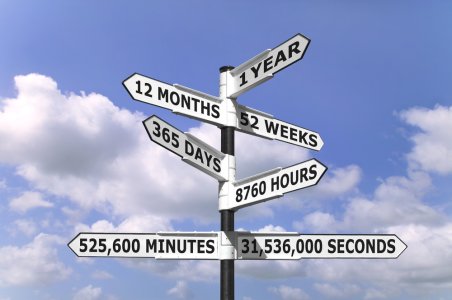Tech Talk with Dr Al: Before my Number’s Up…
- Replies 3
Note from the Editor:
This article was kindly written for the SDC by member Alan G.
When I was at school, we were taught things like ‘The Romans invaded Britain in 55 BC’ and so on. Nobody ever explained how Julius Caesar knew that. What year was it for him? Neither was it ever explained why we had 12 months in the year, apart from the fact that Julius Caesar ‘inserted’ July and August. The only figure in all this we HAD to have was the 365¼ days in every year – a day being measured by the rotation of the Earth and the year being the time taken for the Earth to orbit the Sun. The extra ¼ of a day was taken up (almost) by a leap year having 366 days. We were told that every 3000 years or so, there had to be an ‘adjustment’ because a year wasn’t exactly 365¼ days. Unless they start adding something to my cornflakes in the morning, I really don’t think I’ll be around to experience that.
Why are there 60 seconds in a minute?
This apparently goes back to the Sumerians, who lived from about 5500 BC to 3500 BC – that was before the Egyptians. My research has shown that they used a counting method like this: The right hand has four fingers, each with three sections. The thumb was used to count up to 12 on one hand or up to 60 using the fingers and thumb of the left hand. This technique was passed on to the Babylonians. The Egyptians adopted this counting system as well and are credited with dividing the day into 12 parts using a T-shaped sundial or possibly by the number of lunar cycles in the year. Night-time posed a problem, and they found initially that there were 36 stars that divided the day and night, so they reckoned 18 for the day and 18 for the night. They took away 3 on either end as they were difficult to see and were left with 12.
This was simplified later, in around 1200 BC, when 24 stars marked the passage of time over day and night. These were not equal intervals – daylight intervals were longer than those for night. Despite the proposal by the Greek Hipparchus in about 137 BC to divide the day and night into equal intervals, it wasn’t until around the 14th century, after the invention of clocks, that the concept of 24 equal hours was adopted throughout the world. Before this time, the length of hours was considered to vary with the seasons, as crazy as it sounds.
‘60’ as a counting base for hours, minutes, and seconds has been kept due to its being the smallest number divisible by 2, 4, 6. 10, 12, 15, 20 and 30.
Why are there 12 months in a year?
Before the time of Julius Caesar, the calendar had only 10 months. This was the ‘Roman Calendar’ introduced by King Romulus in 738 BC, with 355 days in a year divided into weeks of 8 days. In 45 BC, Julius Caesar ordered that another two months be added to the calendar to coincide with the solar year, and they named these July and August after the names of Julius Caesar and Augustus, who followed him. In addition, because of the importance of these two months, they were assigned 31 days each. This was the ‘Julian Calendar’ and employed a cycle of three years of 365 days, followed by a year of 366 days (leap year). It also moved the beginning of the year from March 1 to January 1. The other months were named after various gods and festivals:
January: Janus, the two-faced Roman god – named for the transition from one year to the next;
February: The festival of Februalia - involving cleansing sacrifices;
March: The Roman god Mars – Military operations began after the winter thaw;
April: After the Latin word aperio (to open) – the month when buds were opening to herald Spring;
May: The Roman plant goddess Maia;
June: The Roman goddess of marriage, Juno;
July: Originally called ‘Quintilis’, since it had originally been the 5th month when January and February didn’t exist;
August: Originally called ‘Sextilis’, the 6th month;
September to December: Simply the 7th to 10th months of the year before July and August were ‘inserted’.
The ‘Julian’ calendar was replaced in 1882 AD with the ‘Gregorian’ calendar by Pope Gregory XIII to adjust the days of each month for more accurate leap years. Only four countries do not use the Gregorian calendar: Nepal, Ethiopia, Iran and Afghanistan. These countries all use their own calendars. There are also a number of countries that do not use the Gregorian Calendar exclusively – they use it alongside their own calendars. Iran and Afghanistan use the ‘Persian Solar Hijri Calendar’ (not to be confused with the Moslem Hijri calendar), which is reckoned to be the most accurate calendar in the world. Being a ‘solar’ calendar, its time reckoning is based on the Earth's movements around the Sun. The Gregorian calendar follows a set of predetermined rules to stay in sync with the solar year, but the Solar Hijri calendar is based on astronomical observations. The year begins at midnight, closest to the vernal equinox in Iran—specifically at the Iran Standard Time meridian at longitude 52.5° east, which runs about 250 miles (400 km) east of Tehran. The first day of the new year is called Nowruz, about the 21st of March on the Gregorian calendar, and it is celebrated around the world by Iranian people. Because the Solar Hijri calendar is tied so closely to the astronomical seasons, it is far more accurate than the Gregorian calendar, which deviates from the solar year by 1 day in 3236 years.
A year in the Solar Hijri calendar is divided into 12 months of varying lengths. The first 6 months have 31 days, and months 7 through 11 have 30 days. The last month, Esfand, has 29 days in a common year and 30 days in a leap year.
Why are there 7 days in a week?
It seems a strange number to use since it does not immediately appear to have any astronomical or religious reason. Nevertheless, it has been used for millennia from China to India, the Middle East and Europe. Its adoption can be traced back to the Babylonians and the decree of King Sargon I of Akkad around 2300 BC. These people venerated the number seven, and before telescopes, the key celestial bodies, the Sun, the Moon and the five planets visible to the naked eye numbered seven. Incidentally, the seven-day week is also closely linked to Judaism and the story of Genesis, with God resting on the seventh day.
‘Hey, Babylonian! How old are you?’
It’s a fair question, and not one ever dealt with in school, as I mentioned earlier.
In some cultures, people counted their age based on the number of years since they were born, similar to how we count our age today. However, in other cultures, age was not measured in years but in other units, such as lunar months or seasons. The Romans counted their years from the time certain Consuls ruled, but were ‘not big’ on counting the years since historical events occurred. They sometimes dated events from the time of the legendary formation of Rome. It was very similar in Babylonia. The Babylonian’s answer may have been ‘40 Summers’ or something similar. It was the same with the Greeks, who also recalled events based upon which ruler had been in place. Of course, it became quite complicated when trying to communicate with people from other areas, so a number of different rulers may have had to be mentioned.
Dates of events, just like today, were relative to some perceived important occurrence. There was apparently very little known by the Sumerians, Babylonians or Egyptians about events from ‘before their time’.
Conclusions:
We really don’t appear to have progressed very far in our concept of time over the last two or three thousand years. In our society, years are based relatively on the supposed birth of Jesus, either in the positive or the negative direction, instead of (say) the asteroid that was supposed to have wiped out the dinosaurs and allowed smaller mammals as well as primates to evolve. The Chinese have their own calendar but realise they have to align themselves with the Gregorian Calendar if they want to continue trading with the vast majority of countries. I can quite understand why we were never taught about the day-to-day life of earlier civilisations – it was simply ‘in the too-hard basket’!
As much as I’d really love to have 10 months in the year, 36 or 37 days in a month and 6 days in a week, there is really no point. However, I would really like to see ‘weekends’ abolished in favour of a ‘rostered’ 4-day work week. There would be no ‘loading’ for weekends, capital equipment would not be idle for 2 days a week and productivity would increase. Only having to work 4 days would be an incredible bonus. The system would have to be flexible enough for some people to always have (say) Sunday off for Church etc., but I think it would be quite doable.
About the author: Having spent three years living in Australia in his youth, Alan returned to Australia in 1969 with his wife and young child. Holding a Bachelor of Engineering degree and a Doctor of Science Education degree, Alan has experience in flight simulations, Einsteinian physics, and inventing an ‘eye blink’ device that allows cerebral palsy patients to communicate. He even took a turn at acting, starring in a TV advert and landing supporting and lead roles in his local dramatic society plays. His short stories have been published in WA’s The Gingin Buzz for ten years, and his novel The Magic Hourglass is a work in progress. He and his wife have a lovely life in Brisbane and regularly visit their two children in Sydney’s West. You can read Alan’s full-length bio here.
From the Editor:
Wow, I learnt a lot reading this one! If you’d like to see more articles exploring topics like this, be sure to let us know in the comments below!
We were only able to create this content because of the financial support of SDC Rewards members. If you'd like to see more of this (and a lot fewer ads!), please consider supporting us and signing up for SDC Rewards today—it starts at just 14 cents per day.
This article was kindly written for the SDC by member Alan G.
When I was at school, we were taught things like ‘The Romans invaded Britain in 55 BC’ and so on. Nobody ever explained how Julius Caesar knew that. What year was it for him? Neither was it ever explained why we had 12 months in the year, apart from the fact that Julius Caesar ‘inserted’ July and August. The only figure in all this we HAD to have was the 365¼ days in every year – a day being measured by the rotation of the Earth and the year being the time taken for the Earth to orbit the Sun. The extra ¼ of a day was taken up (almost) by a leap year having 366 days. We were told that every 3000 years or so, there had to be an ‘adjustment’ because a year wasn’t exactly 365¼ days. Unless they start adding something to my cornflakes in the morning, I really don’t think I’ll be around to experience that.
Why are there 60 seconds in a minute?
This apparently goes back to the Sumerians, who lived from about 5500 BC to 3500 BC – that was before the Egyptians. My research has shown that they used a counting method like this: The right hand has four fingers, each with three sections. The thumb was used to count up to 12 on one hand or up to 60 using the fingers and thumb of the left hand. This technique was passed on to the Babylonians. The Egyptians adopted this counting system as well and are credited with dividing the day into 12 parts using a T-shaped sundial or possibly by the number of lunar cycles in the year. Night-time posed a problem, and they found initially that there were 36 stars that divided the day and night, so they reckoned 18 for the day and 18 for the night. They took away 3 on either end as they were difficult to see and were left with 12.
This was simplified later, in around 1200 BC, when 24 stars marked the passage of time over day and night. These were not equal intervals – daylight intervals were longer than those for night. Despite the proposal by the Greek Hipparchus in about 137 BC to divide the day and night into equal intervals, it wasn’t until around the 14th century, after the invention of clocks, that the concept of 24 equal hours was adopted throughout the world. Before this time, the length of hours was considered to vary with the seasons, as crazy as it sounds.
‘60’ as a counting base for hours, minutes, and seconds has been kept due to its being the smallest number divisible by 2, 4, 6. 10, 12, 15, 20 and 30.
Why are there 12 months in a year?
Before the time of Julius Caesar, the calendar had only 10 months. This was the ‘Roman Calendar’ introduced by King Romulus in 738 BC, with 355 days in a year divided into weeks of 8 days. In 45 BC, Julius Caesar ordered that another two months be added to the calendar to coincide with the solar year, and they named these July and August after the names of Julius Caesar and Augustus, who followed him. In addition, because of the importance of these two months, they were assigned 31 days each. This was the ‘Julian Calendar’ and employed a cycle of three years of 365 days, followed by a year of 366 days (leap year). It also moved the beginning of the year from March 1 to January 1. The other months were named after various gods and festivals:
January: Janus, the two-faced Roman god – named for the transition from one year to the next;
February: The festival of Februalia - involving cleansing sacrifices;
March: The Roman god Mars – Military operations began after the winter thaw;
April: After the Latin word aperio (to open) – the month when buds were opening to herald Spring;
May: The Roman plant goddess Maia;
June: The Roman goddess of marriage, Juno;
July: Originally called ‘Quintilis’, since it had originally been the 5th month when January and February didn’t exist;
August: Originally called ‘Sextilis’, the 6th month;
September to December: Simply the 7th to 10th months of the year before July and August were ‘inserted’.
The ‘Julian’ calendar was replaced in 1882 AD with the ‘Gregorian’ calendar by Pope Gregory XIII to adjust the days of each month for more accurate leap years. Only four countries do not use the Gregorian calendar: Nepal, Ethiopia, Iran and Afghanistan. These countries all use their own calendars. There are also a number of countries that do not use the Gregorian Calendar exclusively – they use it alongside their own calendars. Iran and Afghanistan use the ‘Persian Solar Hijri Calendar’ (not to be confused with the Moslem Hijri calendar), which is reckoned to be the most accurate calendar in the world. Being a ‘solar’ calendar, its time reckoning is based on the Earth's movements around the Sun. The Gregorian calendar follows a set of predetermined rules to stay in sync with the solar year, but the Solar Hijri calendar is based on astronomical observations. The year begins at midnight, closest to the vernal equinox in Iran—specifically at the Iran Standard Time meridian at longitude 52.5° east, which runs about 250 miles (400 km) east of Tehran. The first day of the new year is called Nowruz, about the 21st of March on the Gregorian calendar, and it is celebrated around the world by Iranian people. Because the Solar Hijri calendar is tied so closely to the astronomical seasons, it is far more accurate than the Gregorian calendar, which deviates from the solar year by 1 day in 3236 years.
A year in the Solar Hijri calendar is divided into 12 months of varying lengths. The first 6 months have 31 days, and months 7 through 11 have 30 days. The last month, Esfand, has 29 days in a common year and 30 days in a leap year.
Why are there 7 days in a week?
It seems a strange number to use since it does not immediately appear to have any astronomical or religious reason. Nevertheless, it has been used for millennia from China to India, the Middle East and Europe. Its adoption can be traced back to the Babylonians and the decree of King Sargon I of Akkad around 2300 BC. These people venerated the number seven, and before telescopes, the key celestial bodies, the Sun, the Moon and the five planets visible to the naked eye numbered seven. Incidentally, the seven-day week is also closely linked to Judaism and the story of Genesis, with God resting on the seventh day.
‘Hey, Babylonian! How old are you?’
It’s a fair question, and not one ever dealt with in school, as I mentioned earlier.
In some cultures, people counted their age based on the number of years since they were born, similar to how we count our age today. However, in other cultures, age was not measured in years but in other units, such as lunar months or seasons. The Romans counted their years from the time certain Consuls ruled, but were ‘not big’ on counting the years since historical events occurred. They sometimes dated events from the time of the legendary formation of Rome. It was very similar in Babylonia. The Babylonian’s answer may have been ‘40 Summers’ or something similar. It was the same with the Greeks, who also recalled events based upon which ruler had been in place. Of course, it became quite complicated when trying to communicate with people from other areas, so a number of different rulers may have had to be mentioned.
Dates of events, just like today, were relative to some perceived important occurrence. There was apparently very little known by the Sumerians, Babylonians or Egyptians about events from ‘before their time’.
Conclusions:
We really don’t appear to have progressed very far in our concept of time over the last two or three thousand years. In our society, years are based relatively on the supposed birth of Jesus, either in the positive or the negative direction, instead of (say) the asteroid that was supposed to have wiped out the dinosaurs and allowed smaller mammals as well as primates to evolve. The Chinese have their own calendar but realise they have to align themselves with the Gregorian Calendar if they want to continue trading with the vast majority of countries. I can quite understand why we were never taught about the day-to-day life of earlier civilisations – it was simply ‘in the too-hard basket’!
As much as I’d really love to have 10 months in the year, 36 or 37 days in a month and 6 days in a week, there is really no point. However, I would really like to see ‘weekends’ abolished in favour of a ‘rostered’ 4-day work week. There would be no ‘loading’ for weekends, capital equipment would not be idle for 2 days a week and productivity would increase. Only having to work 4 days would be an incredible bonus. The system would have to be flexible enough for some people to always have (say) Sunday off for Church etc., but I think it would be quite doable.
About the author: Having spent three years living in Australia in his youth, Alan returned to Australia in 1969 with his wife and young child. Holding a Bachelor of Engineering degree and a Doctor of Science Education degree, Alan has experience in flight simulations, Einsteinian physics, and inventing an ‘eye blink’ device that allows cerebral palsy patients to communicate. He even took a turn at acting, starring in a TV advert and landing supporting and lead roles in his local dramatic society plays. His short stories have been published in WA’s The Gingin Buzz for ten years, and his novel The Magic Hourglass is a work in progress. He and his wife have a lovely life in Brisbane and regularly visit their two children in Sydney’s West. You can read Alan’s full-length bio here.
From the Editor:
Wow, I learnt a lot reading this one! If you’d like to see more articles exploring topics like this, be sure to let us know in the comments below!
We were only able to create this content because of the financial support of SDC Rewards members. If you'd like to see more of this (and a lot fewer ads!), please consider supporting us and signing up for SDC Rewards today—it starts at just 14 cents per day.









